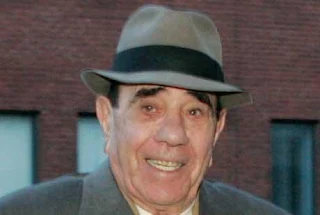(November 5, 1911 – November 11, 2010) |
Early life and career
 Born as Helen Alice Myres in Denver, Colorado, the daughter of Roy and Mary Myres. She soon became — under mysterious circumstances — the child of Leon and Edith Osborn, who called her Marie and added the “e” to the surname, apparently to obscure the adoption.[2] Her foster parents, the Osbornes, introduced their daughter to silent films when they left Colorado to work at Balboa Studios in Long Beach, California. Osborne made her debut in 1914's Kidnapped in New York.
Born as Helen Alice Myres in Denver, Colorado, the daughter of Roy and Mary Myres. She soon became — under mysterious circumstances — the child of Leon and Edith Osborn, who called her Marie and added the “e” to the surname, apparently to obscure the adoption.[2] Her foster parents, the Osbornes, introduced their daughter to silent films when they left Colorado to work at Balboa Studios in Long Beach, California. Osborne made her debut in 1914's Kidnapped in New York.Signed to a lucrative contract with Balboa Films (and working with director Henry King and writer Clara Beranger), by the age of five she was starring in silent films, including her best remembered movie, Little Mary Sunshine from 1916 (see the film's IMDb profile), one of her few films which still survive on celluloid. Some of her other films include Maid of the Wild (1915), Sunshine and Gold (1917), What Baby Forgot (1917), Daddy's Girl (1918), The Locked Heart (1918), Winning Grandma (1918), The Sawdust Doll (1919) and Daddy Number Two (1919). At the age of eight, she completed her final film as a child star, Miss Gingersnap in 1919. In all, she was featured or starred in 29 films in a six year period. Most of her films were produced at Diando Studios, the former Kalem Movie Studio in Glendale, California.
She returned to motion pictures 15 years later – at the request of director Henry King – to appear in his 1934 movie Carolina, starring Janet Gaynor and Lionel Barrymore. Over the next 16 years, Osborne worked as a film extra, additionally serving as a stand-in for actresses such as Ginger Rogers, Deanna Durbin, and Betty Hutton. After appearing in more than a dozen films, she made her last on-screen appearance in Bunco Squad (1950), starring Robert Sterling and Joan Dixon.
Later career
In the 1950s she started a new career as a costumer for Western Costume, a clothing supplier for the motion picture industry. Osborne worked on the wardrobes for such films as Around the World in 80 Days (1956), How to Murder Your Wife (1965), The Godfather: Part II (1974), and Harry and Walter Go to New York (1976). In 1963, Osborne worked as a special costumer for Elizabeth Taylor in the big-budget film, Cleopatra. Osborne retired in 1977, and moved to San Clemente, California.Personal life
Osborne married Frank J. Dempsey on May 2, 1931. Dempsey was the father of Osborne's only child, Joan (born May 13, 1932). They divorced in 1937. Osborne married 36-year old actor Murray F. Yeats on June 14, 1945, and moved to Sepulveda, California. She remained married until his death on January 27, 1975.Death
Marie Osborne Yeats died on November 11, 2010 in San Clemente, California, six days after her 99th birthday. She was survived by her daughter, Joan, and five grandchildren.[3]To see more of who died in 2010 click here












